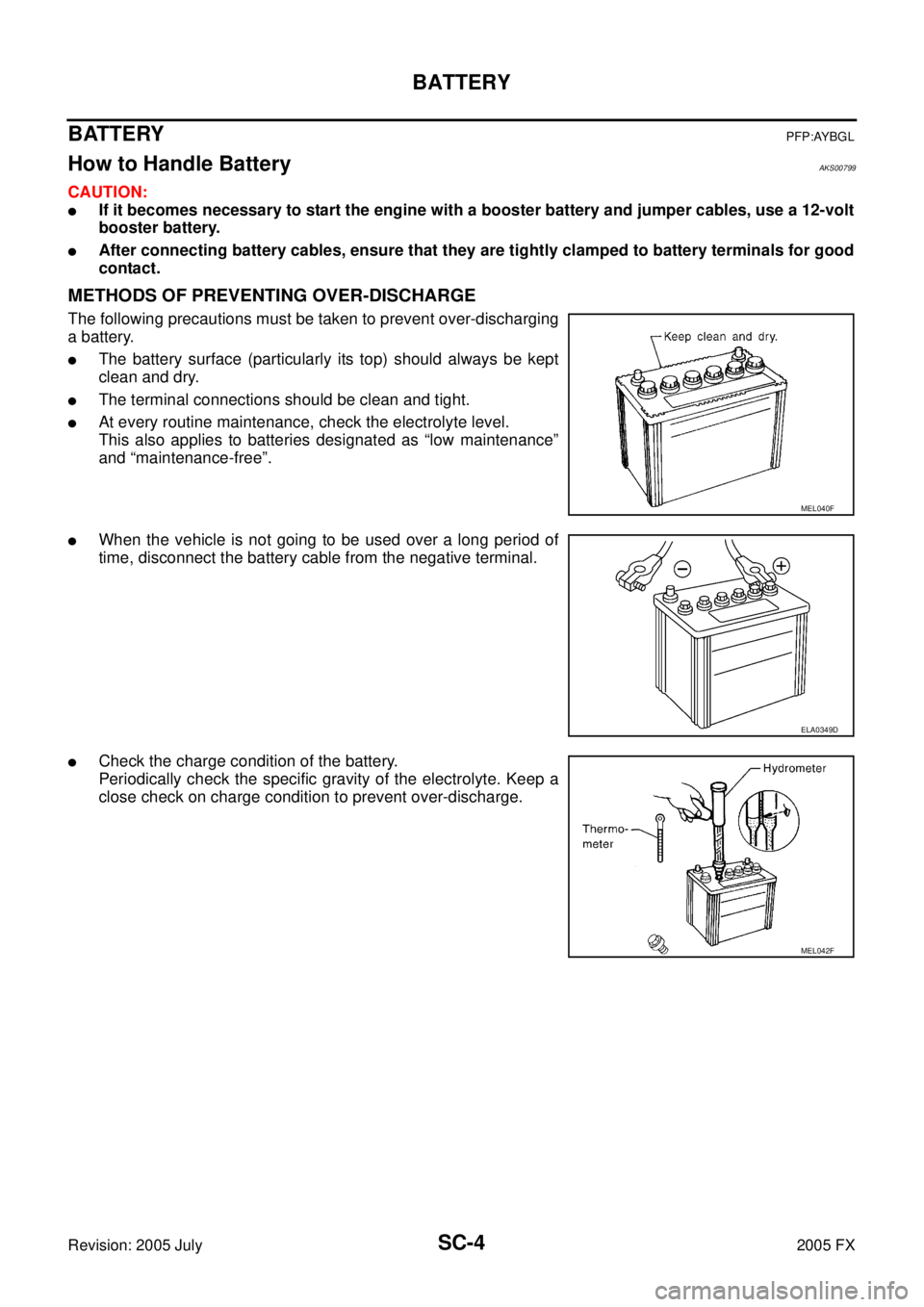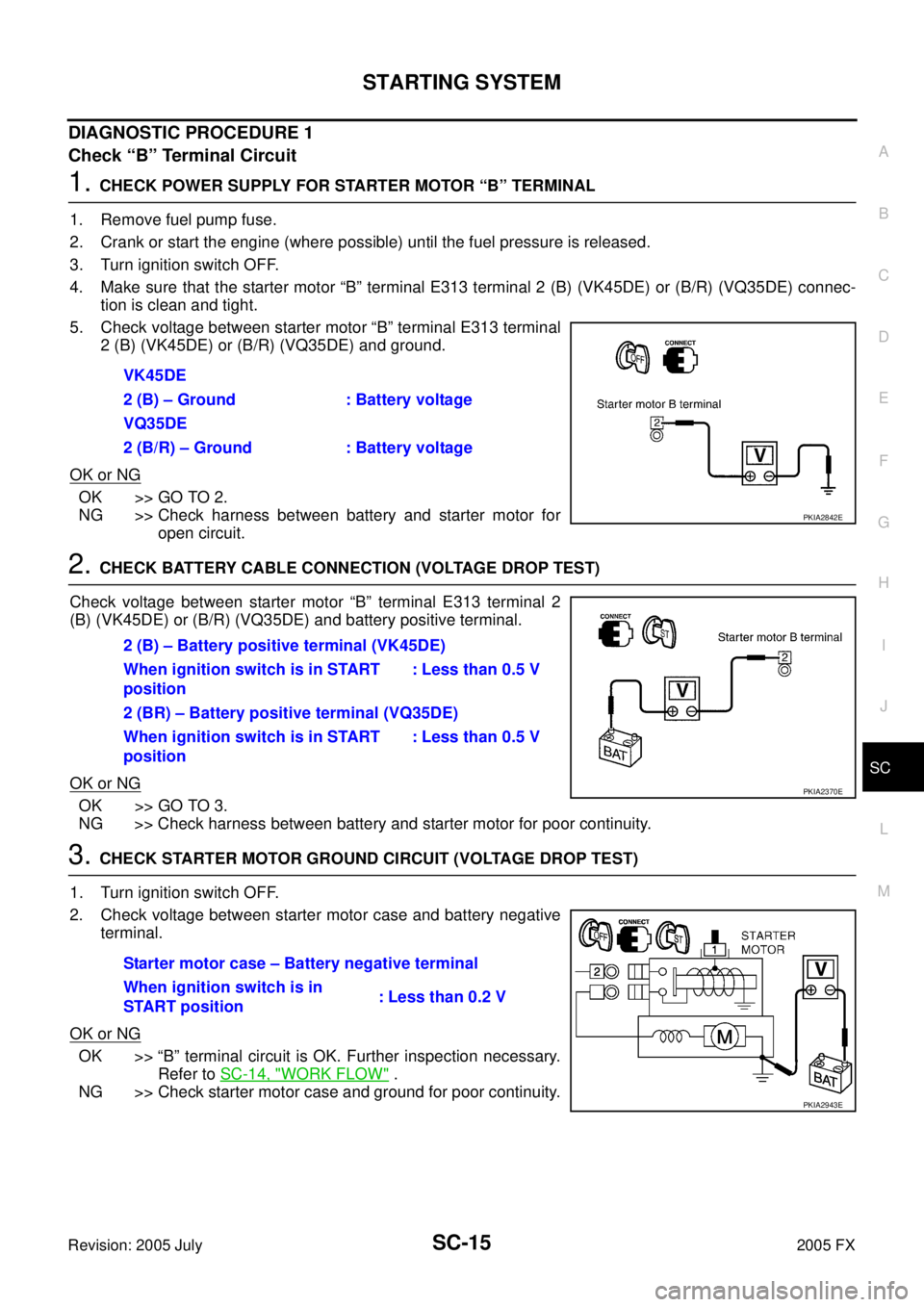Page 4439 of 4731

SC-4
BATTERY
Revision: 2005 July 2005 FX
BATTERYPFP:AYBGL
How to Handle BatteryAKS00799
CAUTION:
�If it becomes necessary to start the engine with a booster battery and jumper cables, use a 12-volt
booster battery.
�After connecting battery cables, ensure that they are tightly clamped to battery terminals for good
contact.
METHODS OF PREVENTING OVER-DISCHARGE
The following precautions must be taken to prevent over-discharging
a battery.
�The battery surface (particularly its top) should always be kept
clean and dry.
�The terminal connections should be clean and tight.
�At every routine maintenance, check the electrolyte level.
This also applies to batteries designated as “low maintenance”
and “maintenance-free”.
�When the vehicle is not going to be used over a long period of
time, disconnect the battery cable from the negative terminal.
�Check the charge condition of the battery.
Periodically check the specific gravity of the electrolyte. Keep a
close check on charge condition to prevent over-discharge.
MEL040F
ELA0349D
MEL042F
Page 4445 of 4731

SC-10
STARTING SYSTEM
Revision: 2005 July 2005 FX
STARTING SYSTEMPFP:23300
System Description AKS0079C
Power is supplied at all times
�through 40A fusible link (letter F, located in the fuse and fusible link block)
�to ignition switch terminal 1,
�through 15A fuse (No. 78, located in the IPDM E/R)
�to CPU of IPDM E/R,
�through 10A fuse (No. 71, located in the IPDM E/R)
�to CPU of IPDM E/R.
When the selector lever in the P or N position, power is supplied
�from TCM, and through A/T assembly terminal 9
�to IPDM E/R terminal 53.
Ground is supplied
�to IPDM E/R terminals 38, 50 and 60
�from grounds E21, E50 and E51.
With the ignition switch in the START position, and provided that the IPDM E/R receives a starter relay ON sig-
nal from the CAN lines, the IPDM E/R is energized and power is supplied
�from ignition switch terminal 5
�to IPDM E/R terminal 4 and
�through IPDM E/R terminal 3
�to starter motor terminal 1.
The starter motor plunger closes and provides a closed circuit between the battery and starter motor. The
starter motor is grounded to the engine block. With power and ground supplied, cranking occurs and the
engine starts.
Page 4446 of 4731
STARTING SYSTEM SC-11
C
D E
F
G H
I
J
L
M A
B
SC
Revision: 2005 July 2005 FX
Wiring Diagram — START —AKS0079D
VK45DE ENGINE MODELS
TKWM1275E
Page 4447 of 4731
SC-12
STARTING SYSTEM
Revision: 2005 July 2005 FX
VQ35DE ENGINE MODELS
TKWM1276E
Page 4448 of 4731

STARTING SYSTEM SC-13
C
D E
F
G H
I
J
L
M A
B
SC
Revision: 2005 July 2005 FX
Trouble Diagnosis with Battery/Starting/Charging System Tester (Starting)AKS0079E
NOTE:
To ensure a complete and thorough diagnosis, the battery, starter and alternator test segments must be done
as a set from start to finish.
1. Turn off all loads on the vehicle electrical system.
2. Perform battery test with Battery/Starting/Charging system tester. Refer to SC-6, "
Trouble Diagnosis with Battery/Starting/
Charging System Tester (Battery)" .
3. Press “ENTER” to begin the starting system test.
4. Start the engine.
5. Diagnostic result is displayed on the tester. Refer to SC-13,
"DIAGNOSTIC RESULT ITEM CHART" .
NOTE:
�If the starter performs normally but the engine does not start,
perform engine diagnosis.
�For intermittent “NO CRANK” or “NO STARTER OPERA-
TION” incidents, refer to SC-16, "
DIAGNOSTIC PROCE-
DURE 2" .
DIAGNOSTIC RESULT ITEM CHART
SEL408X
SEL409X
SEL410X
Diagnostic item Service procedure
CRANKING VOLTAGE NORMAL Go to SC-14, "
WORK FLOW" .
CRANKING VOLTAGE LOW
CHARGE BATTERY Perform the slow battery charging procedure. (Initial rate of charge is 10A for 12 hours.) Per-
form battery test again with Battery/Starting/Charging system tester. Refer to SC-6, "
Trouble
Diagnosis with Battery/Starting/Charging System Tester (Battery)" .
REPLACE BATTERY Before replacing battery, clean the battery cable clamps and battery posts. Perform battery
test again with Battery/Starting/Charging system tester. Refer to SC-6, "
Trouble Diagnosis
with Battery/Starting/Charging System Tester (Battery)" . If second test result is “REPLACE
BATTERY”, then do so. Perform battery test again to confirm repair.
Page 4450 of 4731

STARTING SYSTEM SC-15
C
D E
F
G H
I
J
L
M A
B
SC
Revision: 2005 July 2005 FX
DIAGNOSTIC PROCEDURE 1
Check “B” Terminal Circuit
1. CHECK POWER SUPPLY FOR STARTER MOTOR “B” TERMINAL
1. Remove fuel pump fuse.
2. Crank or start the engine (where possible) until the fuel pressure is released.
3. Turn ignition switch OFF.
4. Make sure that the starter motor “B” terminal E313 terminal 2 (B) (VK45DE) or (B/R) (VQ35DE) connec- tion is clean and tight.
5. Check voltage between starter motor “B” terminal E313 terminal 2 (B) (VK45DE) or (B/R) (VQ35DE) and ground.
OK or NG
OK >> GO TO 2.
NG >> Check harness between battery and starter motor for
open circuit.
2. CHECK BATTERY CABLE CONNECTION (VOLTAGE DROP TEST)
Check voltage between starter motor “B” terminal E313 terminal 2
(B) (VK45DE) or (B/R) (VQ35DE) and battery positive terminal.
OK or NG
OK >> GO TO 3.
NG >> Check harness between battery and starter motor for poor continuity.
3. CHECK STARTER MOTOR GROUND CIRCUIT (VOLTAGE DROP TEST)
1. Turn ignition switch OFF.
2. Check voltage between starter motor case and battery negative terminal.
OK or NG
OK >> “B” terminal circuit is OK. Further inspection necessary. Refer to SC-14, "
WORK FLOW" .
NG >> Check starter motor case and ground for poor continuity. VK45DE
2 (B) – Ground : Battery voltage
VQ35DE
2 (B/R) – Ground : Battery voltage
PKIA2842E
2 (B) – Battery positive terminal (VK45DE)
When ignition switch is in START
position : Less than 0.5 V
2 (BR) – Battery positive terminal (VQ35DE)
When ignition switch is in START
position : Less than 0.5 V
PKIA2370E
Starter motor case – Battery negative terminal
When ignition switch is in
START position : Less than 0.2 V
PKIA2943E
Page 4451 of 4731

SC-16
STARTING SYSTEM
Revision: 2005 July 2005 FX
DIAGNOSTIC PROCEDURE 2
Check “S” Connector Circuit
1. CHECK POWER SUPPLY FOR STARTER MOTOR “S” TERMINAL
1. Remove fuel pump fuse.
2. Crank or start the engine (where possible) until the fuel pressure is released.
3. Turn ignition switch OFF.
4. Disconnect starter motor connector.
5. Check voltage between starter motor harness connector E312 (VK45DE) or F33 (VQ35DE) terminal 1 (B) and ground.
OK or NG
OK >> “S” connector circuit is OK. Further inspection neces- sary. Refer to SC-14, "
WORK FLOW" .
NG >> Check the following.
�40A fusible link (letter F , located in fuse and fusible
link box)
�Ignition switch
�Starter relay (within the IPDM E/R)
�Harness for open or short
MINIMUM SPECIFICATION OF CRANKING VOLTAGE REFERENCING COOLANT TEMPERA-
TURE
1 (B) – Ground
When ignition switch is in
START position : Battery voltage
PKIA2807E
Engine coolant temperature Voltage [V]
− 30 °C to −20 °C ( −22 °F to −4 °F) 8.4
− 19 °C to −10 °C ( −2 °F to 14 °F) 8.9
− 9 °C to 0 °C (16 °F to 32 °F) 9.3
More than 1 °C (More than 34 °F) 9.7
Page 4452 of 4731
STARTING SYSTEM SC-17
C
D E
F
G H
I
J
L
M A
B
SC
Revision: 2005 July 2005 FX
Removal and Installation AKS00BRA
VK45DE ENGINE MODELS
Removal
1. Disconnect the battery cable from the negative terminal.
2. Remove engine front and rear undercover, using power tools.
3. Disconnect “S” connector.
4. Remove “B” terminal nut.
5. Remove starter motor mounting bolts.
6. Loosen A/T fluid cooler tube clip bolts. Refer to AT- 2 7 0 ,
"TRANSMISSION ASSEMBLY" .
7. Remove starter motor downward from the vehicle.
Installation
Installation is the reverse order of removal.
CAUTION:
Be sure to tighten “B” terminal nut carefully.
1. Starter motor 2. Starter motor mounting bolt 3. B terminal harness
4. B terminal nut 5. S connector 6. Cylinder block
: N·m (kg-m, ft-lb) : Engine front
SKIB7206E
PKIA2810E